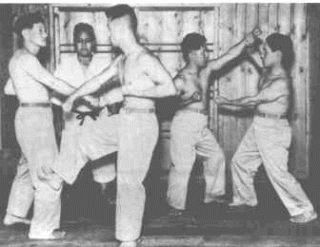BRIEF HISTORY OF GOJU-RYU KARATE-DO



In the sun-drenched Ryukyu Islands, now known as Okinawa, Japan, a martial art was born from necessity and ingenuity some 150 years ago, weaving together the fluid movements of Chinese kung fu with the resilient spirit of local fighting traditions. This was karate-do, the “Way of the Empty Hand,” a discipline that went beyond mere combat to become a path of self-mastery, where practitioners honed not just their fists and feet but their character, striving to conquer their own limitations rather than merely defeating others. In an era when the Ryukyu Kingdom’s rulers forbade peasants from bearing arms, the people turned to their bare hands and feet, crafting a martial art called Te. As this art spread across the islands, it branched into distinct styles, like the robust Naha-te and the agile Shuri-te, each carrying the heartbeat of Okinawa’s defiant spirit.
Into this world stepped Kanryo Higaonna, born on March 10, 1853, in Naha to a merchant family trading firewood, a precious resource in the islands. As a teenager, around the age of 14, he found himself drawn to the art of Te, training under the seasoned master Arakaki Seisho, who had studied the forceful Fukien style of Chinese martial arts. Hungry for deeper knowledge, Higaonna set sail for Fuzhou, China, around 1868, barely in his late teens. In the bustling port city, he immersed himself in Chinese martial arts, most notably under Ru Ru Ko, a master likely tied to White Crane Kung Fu, whose flowing yet powerful techniques left a lasting mark. For roughly a decade, Higaonna absorbed these lessons, blending them with his Okinawan roots. When he returned to Naha around 1881, he carried a new vision, teaching a martial art that fused the hard, unyielding strikes of Naha-te with softer, evasive movements. His system, known as Naha-te, became renowned, particularly for the Sanchin kata, a form so intense that tales spread of Higaonna’s feet gripping the floor with such force it seemed to warm the wood beneath him.
Years later, a young Chojun Miyagi, born in 1888 in Naha, stepped into Higaonna’s dojo at age 14, eager to learn. Under Higaonna’s rigorous guidance, Miyagi forged a deep connection to Naha-te. In 1915, driven by curiosity about his teacher’s roots, Miyagi journeyed to Fuzhou, China, where he studied Chinese martial arts for two years, refining his understanding of the balance between strength and suppleness. Returning to Okinawa in 1917, he mourned Higaonna’s passing in 1915 and took up the mantle of teaching. Miyagi named his system Goju-Ryu, meaning “hard and soft,” capturing the harmony of Sanchin’s forceful stances and the flowing Tensho kata he created. He wove in breathing techniques and callisthenics, crafting a disciplined yet accessible art. Travelling to mainland Japan, Miyagi taught at universities like Kyoto and Ritsumeikan, determined to elevate karate-do to the stature of judo and kendo. In 1933, his efforts bore fruit when karate was registered with Japan’s Butokukai, a milestone that cemented its place among revered martial arts. In 1934, Miyagi penned “An Outline of Karate-do,” a profound work blending technique with spiritual insight, and in 1936, he earned a medal from Japan’s Ministry of Education for his contributions, later training in Shanghai to further deepen his craft.
The story of Goju-Ryu found a new champion in Gogen Yamaguchi, born Jitsumi Yamaguchi in 1909 in Kagoshima, Japan. As a young man in Kyoto, he trained under Takeo Maruta, a Goju-Ryu practitioner and student of Miyagi. Yamaguchi’s passion burned brightly, and while studying law at Ritsumeikan University in the 1930s, he founded a karate club and introduced free-sparring, a revolutionary shift that broke from the rigid kata and pre-arranged drills of the time. In 1937, Chojun Miyagi dubbed him “Gogen,” meaning “rough,” and tasked him with spreading Goju-Ryu across Japan. Yamaguchi’s vision crystallized in 1950 when he founded the All-Japan Karate-do Goju-Kai in Tokyo, organizing the art into a structured, modern system. His introduction of free sparring made Goju-Ryu dynamic and appealing, igniting its popularity in Japan and beyond. Though he explored judo, kendo, iaido, jodo, and even the art of the chain and sickle, karate remained Yamaguchi’s true calling, shaping a legacy that endures.
Goju-Ryu, born from Higaonna’s fusion of Chinese and Okinawan traditions, formalized by Miyagi’s vision, and modernized by Yamaguchi’s innovations, became one of the first Okinawan karate styles to claim its own name, with “Ryu” symbolizing a flowing lineage. As the art spread globally, it shed its regional roots, becoming a universal discipline practiced in dojos worldwide, a testament to the enduring vision of its pioneers.




